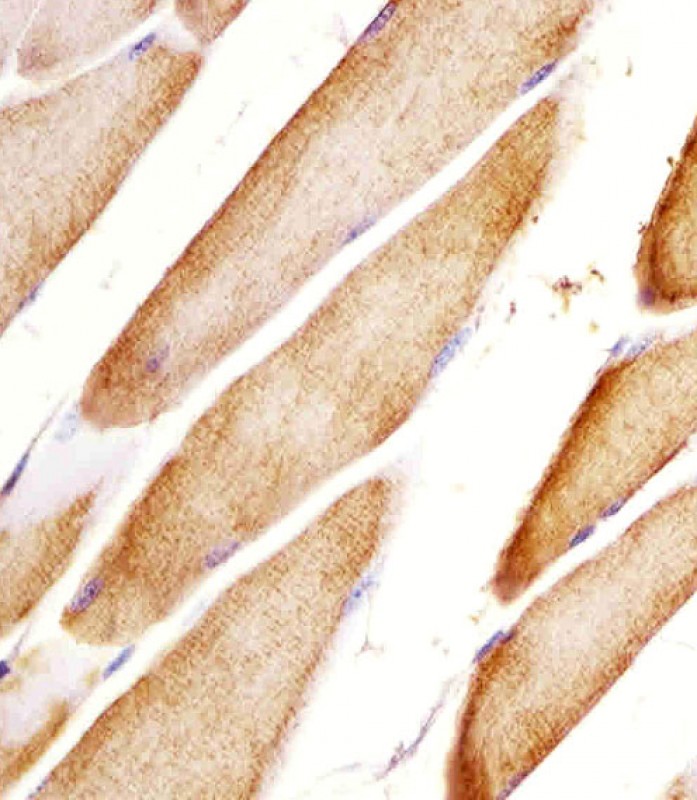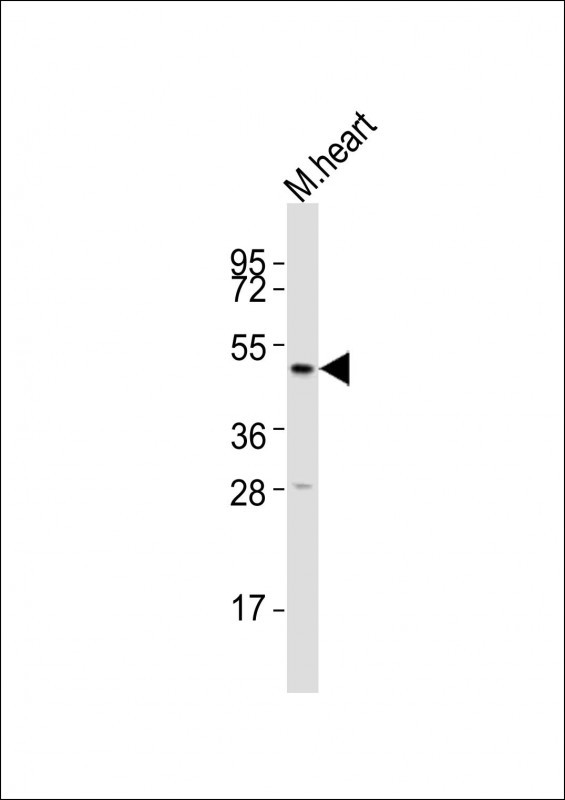Htr2a Antibody (N-term)
Purified Rabbit Polyclonal Antibody (Pab)
- 产品详情
- 实验流程
- 背景知识
Application
| WB, IHC-P, E |
|---|---|
| Primary Accession | P35363 |
| Reactivity | Human, Rat, Mouse |
| Host | Rabbit |
| Clonality | polyclonal |
| Isotype | Rabbit IgG |
| Calculated MW | 52842 Da |
| Gene ID | 15558 |
|---|---|
| Other Names | 5-hydroxytryptamine receptor 2A, 5-HT-2, 5-HT-2A, Serotonin receptor 2A, Htr2a, Htr2 |
| Target/Specificity | This Htr2a antibody is generated from a rabbit immunized with a KLH conjugated synthetic peptide between 16-30 amino acids from the N-terminal region of human Htr2a. |
| Dilution | WB~~1:2000 IHC-P~~1:100~500 E~~Use at an assay dependent concentration. |
| Format | Purified polyclonal antibody supplied in PBS with 0.09% (W/V) sodium azide. This antibody is purified through a protein A column, followed by peptide affinity purification. |
| Storage | Maintain refrigerated at 2-8°C for up to 2 weeks. For long term storage store at -20°C in small aliquots to prevent freeze-thaw cycles. |
| Precautions | Htr2a Antibody (N-term) is for research use only and not for use in diagnostic or therapeutic procedures. |
| Name | Htr2a |
|---|---|
| Synonyms | Htr2 |
| Function | G-protein coupled receptor for 5-hydroxytryptamine (serotonin) (PubMed:11960784, PubMed:16873667, PubMed:17270739, PubMed:18297054, PubMed:21645528, PubMed:23129762, PubMed:23346101). Also functions as a receptor for various drugs and psychoactive substances, including mescaline, psilocybin, 1-(2,5-dimethoxy-4- iodophenyl)-2-aminopropane (DOI) and lysergic acid diethylamide (LSD) (By similarity). Ligand binding causes a conformation change that triggers signaling via guanine nucleotide-binding proteins (G proteins) and modulates the activity of downstream effectors (By similarity). HTR2A is coupled to G(q)/G(11) G alpha proteins and activates phospholipase C-beta, releasing diacylglycerol (DAG) and inositol 1,4,5-trisphosphate (IP3) second messengers that modulate the activity of phosphatidylinositol 3-kinase and promote the release of Ca(2+) ions from intracellular stores, respectively (By similarity). Beta-arrestin family members inhibit signaling via G proteins and mediate activation of alternative signaling pathways (PubMed:18297054). Affects neural activity, perception, cognition and mood (PubMed:18297054). Plays a role in the regulation of behavior, including responses to anxiogenic situations and psychoactive substances (PubMed:16873667, PubMed:17270739, PubMed:18297054, PubMed:23129762). Plays a role in intestinal smooth muscle contraction, and may play a role in arterial vasoconstriction (PubMed:11960784, PubMed:23346101). |
| Cellular Location | Cell membrane; Multi-pass membrane protein. Cell projection, dendrite. Cell projection, axon {ECO:0000250|UniProtKB:P14842}. Cytoplasmic vesicle. Membrane, caveola {ECO:0000250|UniProtKB:P14842}. Presynapse {ECO:0000250|UniProtKB:P14842} |
| Tissue Location | Detected in neurons in brain cortex. Detected in adult intestine, especially in mucosal epithelium, longitudinal and circular layers of muscularis externa and myenteric plexuses. Highly expressed in Paneth cells, and detected at lower levels in enterocytes (at protein level). Detected in neurons in the brain cortex |
For Research Use Only. Not For Use In Diagnostic Procedures.
Provided below are standard protocols that you may find useful for product applications.
BACKGROUND
G-protein coupled receptor for 5-hydroxytryptamine (serotonin). Also functions as a receptor for various drugs and psychoactive substances, including mescaline, psilocybin, 1-(2,5- dimethoxy-4-iodophenyl)-2-aminopropane (DOI) and lysergic acid diethylamide (LSD). Ligand binding causes a conformation change that triggers signaling via guanine nucleotide-binding proteins (G proteins) and modulates the activity of down-stream effectors. Beta-arrestin family members inhibit signaling via G proteins and mediate activation of alternative signaling pathways. Signaling activates phospholipase C and a phosphatidylinositol-calcium second messenger system that modulates the activity of phosphatidylinositol 3-kinase and promotes the release of Ca(2+) ions from intracellular stores. Affects neural activity, perception, cognition and mood. Plays a role in the regulation of behavior, including responses to anxiogenic situations and psychoactive substances. Plays a role in intestinal smooth muscle contraction, and may play a role in arterial vasoconstriction.
REFERENCES
Yang W.,et al.J. Neurosci. Res. 33:196-204(1992).
Fiorica-Howells E.,et al.Am. J. Physiol. 282:G877-G893(2002).
Becamel C.,et al.J. Biol. Chem. 279:20257-20266(2004).
Weisstaub N.V.,et al.Science 313:536-540(2006).
Gonzalez-Maeso J.,et al.Neuron 53:439-452(2007).
终于等到您。ABCEPTA(百远生物)抗体产品。
点击下方“我要评价 ”按钮提交您的反馈信息,您的反馈和评价是我们最宝贵的财富之一,
我们将在1-3个工作日内处理您的反馈信息。
如有疑问,联系:0512-88856768 tech-china@abcepta.com.























 癌症的基本特征包括细胞增殖、血管生成、迁移、凋亡逃避机制和细胞永生等。找到癌症发生过程中这些通路的关键标记物和对应的抗体用于检测至关重要。
癌症的基本特征包括细胞增殖、血管生成、迁移、凋亡逃避机制和细胞永生等。找到癌症发生过程中这些通路的关键标记物和对应的抗体用于检测至关重要。 为您推荐一个泛素化位点预测神器——泛素化分析工具,可以为您的蛋白的泛素化位点作出预测和评分。
为您推荐一个泛素化位点预测神器——泛素化分析工具,可以为您的蛋白的泛素化位点作出预测和评分。 细胞自噬受体图形绘图工具为你的蛋白的细胞受体结合位点作出预测和评分,识别结合到自噬通路中的蛋白是非常重要的,便于让我们理解自噬在正常生理、病理过程中的作用,如发育、细胞分化、神经退化性疾病、压力条件下、感染和癌症。
细胞自噬受体图形绘图工具为你的蛋白的细胞受体结合位点作出预测和评分,识别结合到自噬通路中的蛋白是非常重要的,便于让我们理解自噬在正常生理、病理过程中的作用,如发育、细胞分化、神经退化性疾病、压力条件下、感染和癌症。







